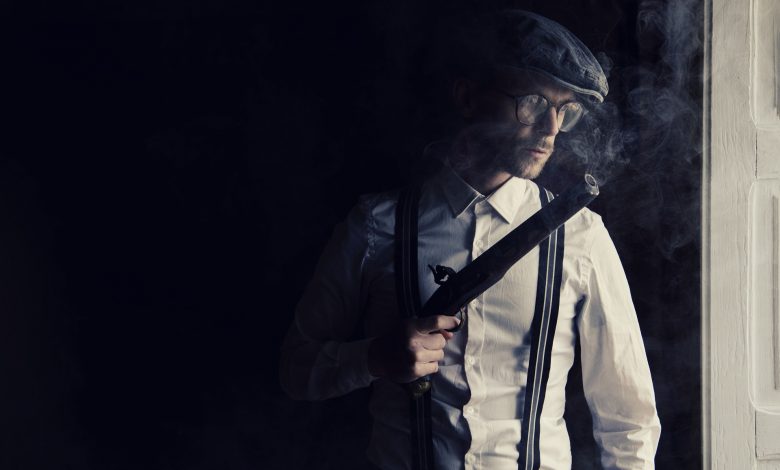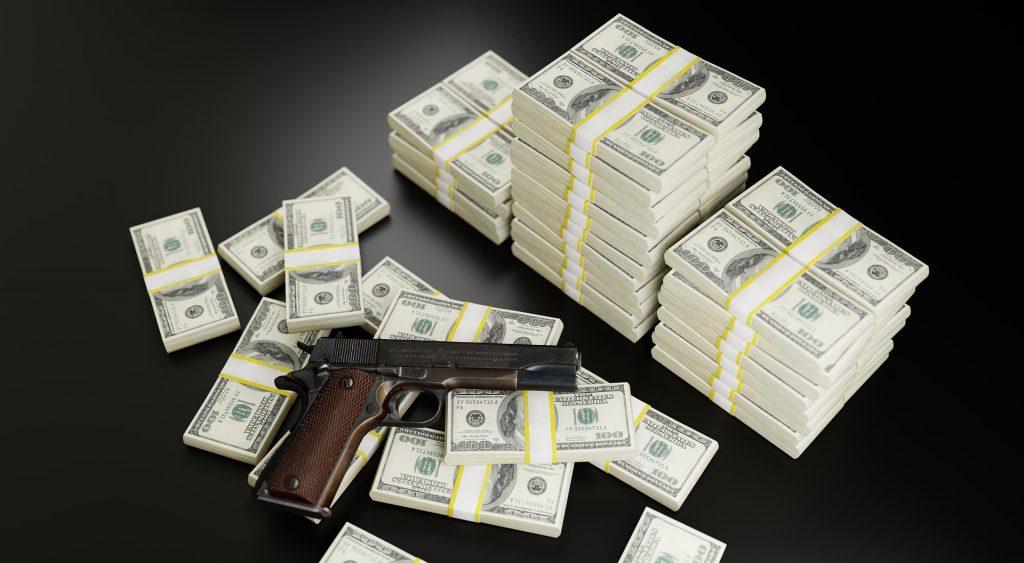Racketeering Explained: The Infamous RICO Statute

Racketeering can describe a wide variety of illegal activities. Typically it refers to using businesses for illegal purposes or illegally taking control of businesses. The infamous RICO Statute was developed to enforce harsher penalties on all types of racketeering activities. Below, we will go over the RICO Act, origins of racketeering, and the history of organized crime in the United States.
What Is the RICO Act?
The Racketeer Influenced Corrupt Organizations Act (RICO Act) is a federal law that allows the United States to extend criminal punishments if certain violations are found. The RICO Act also contains a clause specifically referencing certain acts that are being performed continuously by organized crime organizations.
One of the most important aspects of the RICO Act is that it allows for the leaders of a syndicate to be tried for crimes that they ordered someone else to do. The Act effectively closed a loophole in the system that kept those who instructed another to do something to be exempt from trial.
The Act was enacted by the 901(a) section of the Organized Crime Control Act of 1970. Here’s an excerpt from the statement of findings and purpose:
“The Congress finds that
(1) organized crime in the United States is a highly sophisticated, diversified, and widespread activity that annually drains billions of dollars from America’s economy by unlawful conduct and the illegal use of force, fraud, and corruption;
(2) organized crime derives a major portion of its power through money obtained from such illegal endeavors as syndicated gambling, loan sharking, the theft and fencing of property, the importation and distribution of narcotics and other dangerous drugs, and other forms of social exploitation;
(3) this money and power are increasingly used to infiltrate and corrupt legitimate business and labor unions and to subvert and corrupt our democratic process;
(4) organized crime activities in the United States weaken the stability of the Nation’s economic system, harm innocent investors and competing organizations, interfere with free competition, seriously burden interstate and foreign commerce, threaten the domestic security, and undermine the general welfare of the Nation and its citizens; and
(5) organized crime continues to grow because of defects in the evidence-gathering process of the law inhibiting the development of the legally admissible evidence necessary to bring criminal and other sanctions or remedies to bear on the unlawful activities of those engaged in organized crime and because the sanctions and remedies available to the Government are unnecessarily limited in scope and impact.
It is the purpose of this Act to seek the eradication of organized crime in the United States by strengthening the legal trials in the evidence-gathering process, by establishing new penal prohibitions, and by providing enhanced sanctions and new remedies to deal with the unlawful activities of those engaged in organized crime.”
The RICO statute was signed into law by Richard Nixon as Title IX of the Organized Crime Control Act. Originally, it was used to prosecute high-level members of the Mafia and others who were actively taking part in organized crime. By 1972, 33 states had adopted RICO laws.

What Is Racketeering?
Racketeering is a term created to describe organized crime activity. The phrase was coined in 1927 by the Employers’ Association of Chicago when speaking about organized crime that was taking place in the Teamsters union. The word is derived from “racket,” which also describes organized crime activity. Examples include a protection racket, numbers racket, or gambling racket.
Mafia families getting involved in labor unions was not limited to Chicago. For many decades in New York, it is believed that every significant construction project was being controlled by the Mafia. The way a labor union racket worked is that mob families would either pay off union leaders or threaten them to get a cut of the action. Eventually, Mafia members worked their way up labor union organizations, such as the Teamsters, and once they had full control, they had power over an entire industry.
Penalty for Racketeering
Under the RICO statute, someone that has committed at least two acts of racketeering within a ten-year span can be charged with racketeering—as long as the acts are related to an “enterprise.” These acts of racketeering can be drawn from a list of 35 crimes. If someone is found guilty of racketeering, they face a fine of up to $25,000 and can be sentenced to 20 years in jail for each racketeering count.
Examples of Racketeering Crimes
Under 18 U.S. Code §?1961, the following crimes are considered acts of racketeering:
- Violation of state statutes involving controlled substances, bribery, robbery, arson, extortion, kidnapping, murder, and gambling
- Violation of federal statutes against murder-for-hire, money laundering, gambling, slavery, obstruction of justice, fraud, embezzlement, theft, counterfeiting, and bribery
- Embezzling union funds
- Securities or bankruptcy fraud
- Drug trafficking
- Copyright infringement
- Money laundering and related offenses
- Aiding or assisting illegal aliens in entering the country
- Acts of terrorism
What Is the Mafia?
When you see the term Mafia capitalized, it refers to the Italian (Sicilian) crime organization and its Italian American Mafia offshoot in the U.S. When the word mafia is in lowercase, it refers to similar organized crime in other locations, such as the Russian mafia. Members of the Italian American Mafia often refer to themselves as Cosa Nostra, and the U.S. government refers to them as La Cosa Nostra.
The first known Sicilian Mafia member to come to the United States was Giuseppe Esposito. After murdering the chancellor, vice-chancellor, and 11 landowners in a Sicilian province, Esposito and six others fled to New York. They made their way into New Orleans in 1880, where Esposito changed his name to Vincenzo Rebello, bought a boat, and pretended to be a fisherman. But in 1881, he was arrested by officer David Hennessey and James Mooney and was charged with murder, attempted murder, and robbery. He was eventually shipped back to Italy, and the rest of his life is unknown.
New Orleans is also the location for the first significant Mafia incident in the United States. On October 15, 1890, Esposito’s arresting officer and now Police Superintendent David Hennessey was killed execution-style. Hundreds of Italian Americans were arrested, and 19 were indicted for murder. However, all 19 were acquitted amidst rumors of intimidated witnesses and widespread bribery. In response to the perceived injustice, a lynch mob hung and shot 11 of the 19 defendants.
Early History of the Mafia – Al Capone
Al Capone was one of the first most recognizable Mafia figures in America. Capone co-founded and became the boss of the Chicago Outfit during the prohibition era. Capone’s parents immigrated to the United States in 1893 from Naples, Italy, and he was born in 1899 in New York City. At the age of 14, Capone dropped out of school after striking a teacher.
Young Al Capone
After dropping out, Capone went on to work odd jobs while serving for two “kid gangs” called the South Brooklyn Rippers and the Forty Thieves Juniors. These kinds of gangs were common in New York and consisted of delinquent kids that carried out petty crimes and vandalism.
Capone went on to join the James Street Boys, a gang that was run by Johnny Torrio, who would become Capone’s mentor. At 16-years-old, Capone joined the Five Points Gang and worked with an aspiring mobster and Torrio’s associate, Francesco Ioele, known as Franky Yale. Capone worked as a bartender at Yale’s saloon-brothel, the Harvard Inn.
Capone was involved in many violent scraps, including one at the Harvard Inn that would lead to his nickname “Scarface.” One of his final violent incidents in New York was when 21-year-old Capone shot and killed the winner of a craps game and stole his winnings. The final straw was when Capone viciously assaulted a member of a rival gang called the White Hand. After Capone left him for dead, White Hand vowed retribution. So Yale sent Capone, his wife, and child to work for Torrio in Chicago.
Capone Arrives in Chicago
Torrio moved to Chicago in 1909 to help Chicago crime boss Big Jim Colosimo run his expansive brothel business. In 1920, shortly after Capone’s arrival, Colosimo was assassinated. It is believed that either Yale or Capone killed Colosimo to make way for Torrio to take over the business.
In 1925, after being wounded in an assassination attempt, Torrio retired to Brooklyn, leaving Capone as the man in charge of Chicago. While in charge, Capone oversaw bootlegging, gambling, and prostitution rackets, while expanding his territory through brute force. As the top dog in Chicago, Capone had more men underneath him than the rest of his rivals, an estimated 600, so they proceeded to gun down each rival gang one at a time. Capone was always able to avoid conviction, more often than not, due to no witnesses or witness intimidation.
At his peak, it was estimated that Capone’s wealth totaled $100 million, which would be worth close to $1.5 billion today. And despite his many violent incidents, Capone was viewed as a celebrity gangster by the public. Here is part of an interview from the book Get Capone by Jonathan Eig:
“There were hardly any incidents in which innocent civilians were killed in these gang wars. It was really the gangsters being killed. And because the police weren’t doing anything to stop these guys, the fact that some of them died didn’t stir a lot of sympathy among most Chicagoans. The real issue for most Chicagoans was the damage it did to the city’s reputation. We already had an image of corrupt politics, we had a mayor who was widely perceived as being one of the most venal in the country’s history, and then you’ve got these gangsters walking down the street with machine guns shooting it out on Michigan Avenue in broad daylight. This is, as you can imagine, not good for business. So the city’s business leaders are really the first to raise a ruckus and say, ‘Something must be done about this.'”
Capone Convicted of Tax Fraud
In the late 1920s, Capone was in and out of jail for contempt of court and concealed weapons charges, each coming with one-year sentences. Capone was always let out early on good behavior, but the U.S. Treasury Department had been hard at work compiling evidence of tax evasion. On June 16, 1931, Capone thought he had struck a plea deal and pled guilty to the charges. Capone boasted to the press about his two and a half year sentence, as the sentence for similar crimes was normally three to four years. But the judge informed him that his deal came from a different judge and was no longer on the table.
Capone then pled not guilty. He was convicted on October 18, 1931, and was sentenced to 11 years in jail. Capone would never return to Chicago, suffering from a mental illness resulting from syphilis. In 1946, a doctor concluded that Capone had the mental capacity of a 12-year-old. He died in 1947 as a result of a stroke and pneumonia.
Early History of the Mafia – Maranzano and Masseria
By the end of the 1920s, there were two main factions holding power in New York: the Masseria group and the Maranzano group. Joseph “The Boss” Masseria controlled the two factions, and in 1928, he attempted to gain control of all organized crime throughout the country. The struggle for power became known as the “Castellammarese War,” named after the town where Salvatore Maranzano was born.
The war came to an end in 1931 when Maranzano conspired with Masseria’s right-hand man, Charles “Lucky” Luciano, to have “The Boss” killed. After the successful hit was carried out, Maranzano became the most powerful Mafia figure in the country. He went on to set up five crime groups in New York and called himself “Boss of Bosses.”
With Maranzano’s ascension, it was the first time that La Cosa Nostra was fully organized. Maranzano established a code of conduct and structured divisions based on families, along with a procedure for resolving disputes.
Lucky Luciano Takes Over
The two most powerful groups to emerge from the restructuring are the Gambino and Genovese families. Lucky Luciano was named the first boss of the Genovese family. Five months later, he had sent five men posing as police officers to kill Maranzano. Luciano took over and became the most powerful mob boss in the country.
Similar to Maranzano, Luciano reorganized La Cosa Nostra and set up “The Commission.” The Commission was made up of bosses from seven families, and different rackets were divided up between them. However, in 1936, Luciano was convicted of prostitution charges and was sentenced to 30 years in prison. He was released ten years later but deported to Italy and never returned to the United States. From Itay, Luciano acted as a liaison between La Cosa Nostra and the Sicilian Mafia.
Costello and Genovese
In Luciano’s absence, Frank Costello took over as acting boss because Vito Genovese, who was second in command, had gone back to Italy to avoid murder charges. However, Genovese returned when a key witness in the case was poisoned, and the charges were dropped.
Costello remained in control of the family for 20 years until May 1957, when Genovese sent a soldier to murder him. Costello survived but relinquished his role to Genovese, who named the family after himself. In 1959, Genovese was convicted of conspiracy to violate narcotics laws. He was sent to jail for 15 years but continued to run the family from his cell.
Joseph Valachi
“Made man” Joseph Valachi was sent to the same prison as Genovese in 1962. Labeled as an informant, Valachi survived three attempts on his life. He later killed the man that he believed Genovese had sent to kill him, and he was sentenced to life in prison.
After the sentencing, Valachi decided to cooperate with the FBI. He testified that he was a member of a secret criminal organization known as La Cosa Nostra and revealed a number of secrets. In 1969, Genovese died in prison. Less than a year later, the RICO Act was in place.

Famous Racketeering Cases
The RICO statute was originally intended to target organized crime, but its use has been broadened in the decades that followed.
Key West Police Department
In 1984, the Key West Police Department was declared a criminal enterprise under the RICO statute, and several high-ranking officers were arrested. Federal charges were handed down, and the officers were convicted of running a protection racket for cocaine smugglers.
Major League Baseball
In 2001, MLB owners voted to contract two teams, most likely the Montreal Expos and Minnesota Twins. A year later, owners of the Expos filed charges against MLB under the RICO Act claiming that MLB Commissioner Bud Selig and former Expos owner Jeffrey Loria conspired to devalue the franchise for personal gain in preparation for moving the team. If found guilty, MLB would have been responsible for $300 million in damages. The case was sent to arbitration and was ruled in favor of MLB, allowing the franchise to move to Washington.
FIFA
In 2015, fourteen people associated with FIFA were indicted under 47 counts of violating the RICO Act. The charges included racketeering, money laundering, and wire fraud, among other charges in a 24-year scheme for personal gain through the corruption of international soccer.



